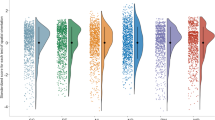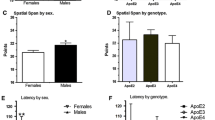Abstract
Four paper-and-pencil spatial tests, measuring two- and three-dimensional spatial visualization and spatial orientation, were administered to 2508 Caucasian high-school studients. Sibling correlations and within-sex score distributions were examined for the influence of a major sex-linked gene. Sex-linked influences were most clear on the test of two-dimensional visualization and on an average of the standard scores on all the tests. For those tests best fitting the genetic model, estimates of the frequency of the recessive gene (contributing to good performance) were near 0.45. There was evidence of sex limitation and a small amount of assortative mating, but no evidence of incomplete dominance in females. Environmental or non-sex-linked genetic factors influenced spatial performance but did not systematically improve performance with age.
Similar content being viewed by others
References
Block, J. B. (1968). Hereditary components in the performance of twins on the WAIS. In Vandenberg, S. G. (ed.),Progress in Human Behavior Genetics, Johns Hopkins Press, Baltimore.
Bock, R. D., and Kolakowski, D. (1973). Further evidence of sex-linked major-gene influence on human spatial visualizing ability.Am. J. Hum. Genet. 25:1–14.
Bohidar, N. R. (1964). Derivation and estimation of variance and covariance components associated with covariance between relatives under sexlinked transmission.Biometrics 20:505–521.
Day, N. E. (1969). Estimating the components of a mixture of normal distributions.Biometrika 56:463–474.
Falconer, D. S. (1960).Introduction to Quantitative Genetics, Ronald Press, New York.
French, J. W. (1951). The description of aptitude and achievement tests in terms of rotated factors.Psychom. Monogr. 5:1–278.
French, J. W., Ekstrom, R. B., and Price, L. A. (1963).Manual for Kit of Reference Tests for Cognitive Factors, Educational Testing Service, Princeton, N.J.
Hartlage, L. C. (1970). Sex-linked inheritance of spatial ability.Percept. Mot. Skills 31:610.
Kempthorne, O. (1957).An Introduction to Genetic Statistics, Wiley, New York.
Michael, W. B., Guilford, J. P., Fruchter, B., and Zimmerman, W. S. (1957). The description of spatial-visualization abilities.Educ. Psychol. Meas. 17:185–199.
Morrison, D. F. (1967).Multivariate Statistical Methods, McGraw-Hill, San Francisco.
Osborne, R. T., and Gregor, A. J. (1968). Racial differences in heritability estimates for tests of spatial ability.Percept. Mot. Skills 27:735–739.
Shepard, R. N., and Feng, C. (1972). A chronometric study of mental paper folding.Cognitive Psychol. 3:228–243.
Shepard, R. N., and Metzler, J. (1971). Mental rotation of three-dimensional objects.Science 171:701–703.
Stafford, R. E. (1961). Sex differences in spatial visualization as evidence of sex-linked inheritance.Percept. Mot. Skills 13:428.
Stafford, R. E. (1963).An Investigation of Similarities in Parent-Child Test Scores for Evidence of Hereditary Components, Educational Testing Service, Princeton, N.J.
Thorndike, E. L. (1921). On the organization of the intellect.Psychol. Rev. 28:141–151.
Thurstone, L. L., and Thurstone, T. G. (1965).Primary Mental Abilities Technical Report, Science Research Associates, Chicago.
Vandenberg, S. G. (1967). Hereditary factors in psychological variables in man, with special emphasis on cognition. In Spuhler, J. N. (ed.),Genetic Diversity and Human Behavior, Aldine, Chicago.
Vandenberg, S. G. (1969). A twin study of spatial ability.Multivariate Behav. Res. 4:273–294.
Vandenberg, S. G., Stafford, R. E., and Brown, A. M. (1968). The Louisville twin study. In Vandenberg, S. G. (ed.),Progress in Human Behavior Genetics, Johns Hopkins Press, Baltimore.
Yen, W. M. (1973). Sex-linked major-gene influences on human spatial abilities. Unpublished doctoral dissertation, University of California, Berkeley.
Author information
Authors and Affiliations
Additional information
Major portions of this research were completed when the author was a doctoral candidate at the University of California, Berkeley, California.
Rights and permissions
About this article
Cite this article
Yen, W.M. Sex-linked major-gene influences on selected types of spatial performance. Behav Genet 5, 281–298 (1975). https://doi.org/10.1007/BF01066180
Received:
Accepted:
Issue Date:
DOI: https://doi.org/10.1007/BF01066180




